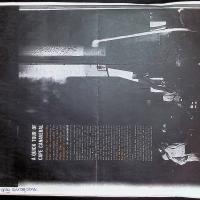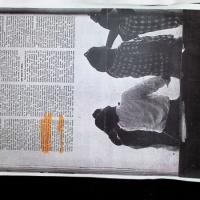A Quick Tour of Cape Canaveral
Item
Title
A Quick Tour of Cape Canaveral
Description
An article by Ian Sclanders from Maclean's magazine, detailing why Cape Canaveral was the United States' choice to be their primary rocket launch center during the space race, and the effects the rocket launches had on the surrounding area. The first page shows a photo of the bottom half of a rocket with several men standing at its base. This page also contains handwriting along its left side, reading, "Maclean's Feb. 24, 1962". The next two pages are adorned at the bottom with photos of people looking up and shielding their eyes with their hands, as if watching a rocket take off.
The reasons provided for why Cape Canaveral was chosen as the United States' primary rocket launch center are: 1. It is very flat, 2. It is remote and thinly populated, and 3. There is a 5,000 mile stretch of ocean from Canaveral to Ascension Island, acting as a perfect missile testing range with minimal risk should accidents occur. Many of those who lived nearby were given $60,000,000 to vacate the area and deed the government an additional 72,000 acres. This land would be used for, "six moon-rocket launching complexes that 4,300 workers will construct at a cost of $700,000,000 over the next three or four years, and also for a buffer zone to isolate the mighty explosive force and the ear-shattering din of the coming moon shots, which will have a thrust of 12,000,000 or more pounds each."
The article also notes how there are tracking stations that track the missiles launched at Canaveral. They are located on "Grand Bahama Island, San Salvador, Mayaguana, Grand Turk, Hispaniola, Puerto Rico, Antigua, St. Lucia, Fernando de Noronha and Ascension Island." The stations were operated by Pan-American World Airways, but were each under the command of a U.S. Air Force officer with RCA (Radio Corporation of America) recording the signals from the rockets.
Brevard County soon became the quickest growing county in the U.S., with surrounding cities like Cocoa Beach growing rapidly because of the rocket launch center. Cocoa Beach went from having around four-hundred residents to six thousand, quickly becoming home to thirty motels and twenty restaurants, and adopting the moniker, "Platinum Strip." Real estate prices in Cocoa Beach tripled during the fifties and sixties, with similar increases occurring in other towns and cities near Canaveral as well.
The reasons provided for why Cape Canaveral was chosen as the United States' primary rocket launch center are: 1. It is very flat, 2. It is remote and thinly populated, and 3. There is a 5,000 mile stretch of ocean from Canaveral to Ascension Island, acting as a perfect missile testing range with minimal risk should accidents occur. Many of those who lived nearby were given $60,000,000 to vacate the area and deed the government an additional 72,000 acres. This land would be used for, "six moon-rocket launching complexes that 4,300 workers will construct at a cost of $700,000,000 over the next three or four years, and also for a buffer zone to isolate the mighty explosive force and the ear-shattering din of the coming moon shots, which will have a thrust of 12,000,000 or more pounds each."
The article also notes how there are tracking stations that track the missiles launched at Canaveral. They are located on "Grand Bahama Island, San Salvador, Mayaguana, Grand Turk, Hispaniola, Puerto Rico, Antigua, St. Lucia, Fernando de Noronha and Ascension Island." The stations were operated by Pan-American World Airways, but were each under the command of a U.S. Air Force officer with RCA (Radio Corporation of America) recording the signals from the rockets.
Brevard County soon became the quickest growing county in the U.S., with surrounding cities like Cocoa Beach growing rapidly because of the rocket launch center. Cocoa Beach went from having around four-hundred residents to six thousand, quickly becoming home to thirty motels and twenty restaurants, and adopting the moniker, "Platinum Strip." Real estate prices in Cocoa Beach tripled during the fifties and sixties, with similar increases occurring in other towns and cities near Canaveral as well.
Creator
Ian Sclanders
Date
February 24, 1962
Format
Magazine Article
Language
English
Subject
The Way the Crow Flies
Source
From AMM's personal archive


